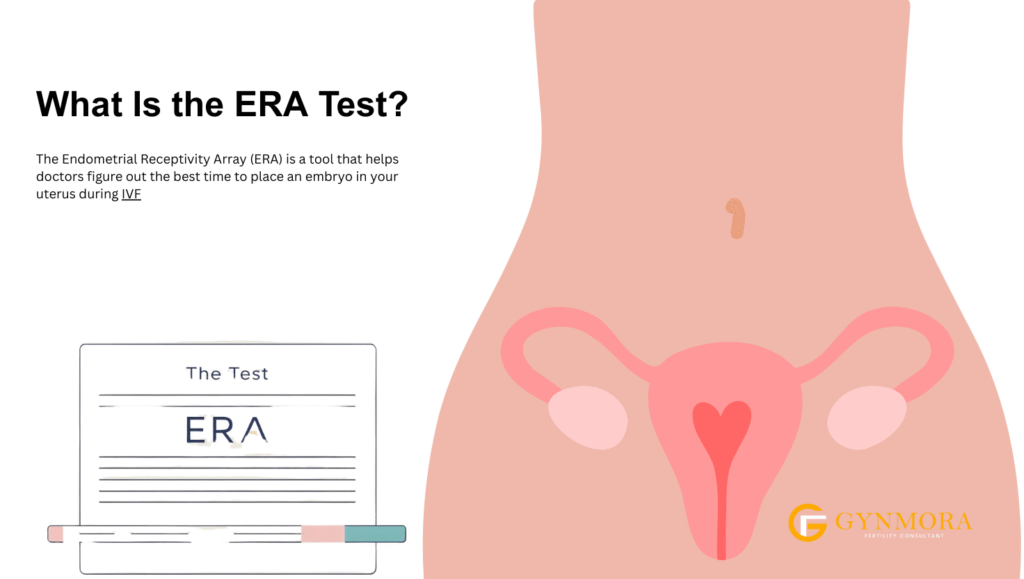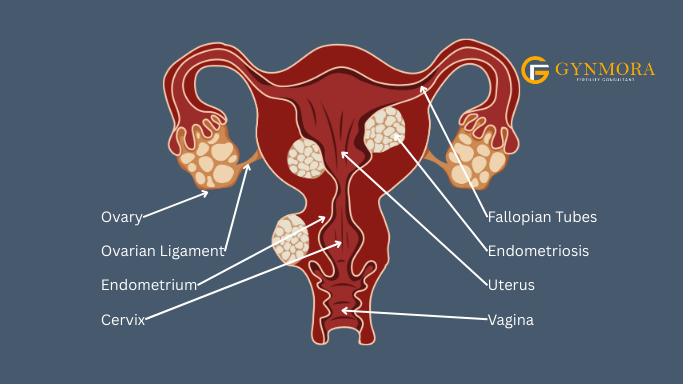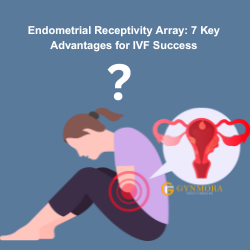Endometrial Receptivity Array
Key Points
- The Endometrial Receptivity Array (ERA) is a test that checks when your uterus is ready for an embryo during IVF, potentially boosting pregnancy chances.
- It’s most helpful for women with repeated IVF failures, but its benefits for all patients are debated.
- The test involves a simple biopsy and analyzes 236 genes to find your unique implantation window.
- Research shows mixed results—some studies suggest improved outcomes, while others find no significant benefit.
- Talk to your doctor to see if ERA fits your fertility plan.
What Is the ERA Test?

The Endometrial Receptivity Array (ERA) is a tool that helps doctors figure out the best time to place an embryo in your uterus during IVF. It checks if the lining of your uterus (the endometrium) is ready to welcome an embryo. By analyzing 236 genes, it pinpoints your personal “window of implantation.” At GYNMORA, we use this test to help make your fertility journey smoother, especially if you’ve had trouble with IVF before.
Why Does Timing Matter?
Getting pregnant through IVF isn’t just about having a healthy embryo—it’s also about timing. If the embryo is transferred when your endometrium isn’t ready, it might not stick. The ERA test helps solve this by finding the exact moment your uterus is most receptive, which could make all the difference.
Is It Right for You?

Endometrial Receptivity Array | The ERA test is often recommended for women who’ve had multiple failed IVF cycles or miscarriages, but it’s not for everyone. Some studies support its use, while others question its value for all patients. Your fertility doctor at GYNMORA can help you decide if it’s worth trying based on your unique situation.
1. What Is the Endometrial Receptivity Array?

Hey there! If you’re exploring fertility treatments, you’ve probably heard that timing is super important. The Endometrial Receptivity Array (ERA) is like a high-tech calendar for your uterus. It’s a test that checks when the lining of your uterus (called the endometrium) is ready to welcome an embryo during IVF. By looking at the activity of 236 specific genes, the ERA figures out your unique “window of implantation”—the best time for an embryo to stick and grow. At GYNMORA, we love how this test helps personalize your fertility plan, especially if you’ve had bumps along the IVF road.
Think of it like planting a seed: you need the soil to be just right. The ERA makes sure your uterus is ready at the perfect moment, which can make a big difference in getting pregnant.
2. How Does the ERA Test Work?
So, how does this test actually work? It’s pretty straightforward, but let’s break it down:
- Mock Cycle: You’ll take hormones (like estrogen and progesterone) to prep your uterus, just like you would for an IVF embryo transfer. This “mock” cycle mimics the real thing without using an embryo.
- Biopsy Time: On the day when an embryo would normally be transferred (usually after 5 days of progesterone), your doctor takes a tiny sample of your endometrium. It’s a quick procedure done in the office, and while it might feel like mild cramps, it’s over fast.
- Gene Check: The sample goes to a lab where scientists look at 236 genes that show if your uterus is ready for an embryo. These genes are like a checklist for receptivity.
- Results: The test tells you if your uterus was “receptive” (ready) or “non-receptive” (not ready yet). If it’s not ready, it shows whether your window is earlier or later than usual.
- Next Steps: Your doctor uses this info to time your real embryo transfer perfectly in the next cycle.
This personalized approach can be a game-changer, especially if timing has been off in past IVF tries.
3. Who Can Benefit from the ERA Test?
Wondering if the ERA is for you? It’s not for everyone, but it’s a great option for some. Here’s who might benefit most:
- Women with Repeated IVF Failures: If you’ve had multiple IVF cycles where good-quality embryos didn’t implant, the ERA could spot if timing is the issue. Research shows about 27.5% of women with recurrent implantation failure (RIF) have a shifted window of implantation (PMC Study).
- Those with Miscarriage History: If you’ve had repeated pregnancy losses, the ERA might help ensure the embryo is transferred at the right time.
- Anyone Curious About Timing: Some clinics offer ERA to all IVF patients, but it’s pricier and not always needed, so talk to your doctor.
At GYNMORA, our fertility specialists can check your history and see if ERA makes sense for you. It’s all about finding what works for your body.
4. What to Expect During the ERA Test
Okay, let’s talk about what actually happens when you get the ERA test. Don’t worry—it’s not as scary as it sounds! Here’s the step-by-step:
- Chat with Your Doctor: You’ll talk about why ERA might help and what to expect. Your doctor will plan a mock cycle to prep your uterus.
- Hormone Prep: You’ll take hormones (pills, patches, or shots) to get your endometrium ready, just like in an IVF cycle. This usually takes a couple of weeks.
- Ultrasound Check: Your doctor might use an ultrasound to make sure your uterine lining is thick enough.
- The Biopsy: On the big day (often day 5 of progesterone), your doctor uses a thin tube to take a small sample of your endometrium. It takes a few minutes and feels like period cramps for most people.
- Lab Time: The sample is sent to a lab (like Igenomix) for gene analysis. Results come back in a few weeks.
- Planning Ahead: Your doctor will go over the results and tweak your IVF plan if needed. If your window is off, they might adjust the transfer day.
The biopsy might sound intense, but it’s quick, and you can usually go back to your day right after. Some women feel a bit sore, but it’s no big deal for most.
5. Success Rates: Does ERA Really Help?
You’re probably wondering, “Will this test actually get me pregnant?” The answer isn’t black-and-white, but let’s look at what we know:
- Promising Studies: Some research is super encouraging. A study found that women with recurrent implantation failure who used ERA-guided transfers had better pregnancy rates (PMC Study). Another showed ERA helped 24% of RIF patients in Japan (PMC Japan Study).
- Mixed Results: Not all studies agree. A 2023 review found no clear boost in pregnancy rates for women using ERA in euploid embryo transfers, even with past failures (Frontiers Review). Another study saw similar live birth rates with or without ERA (56.5% vs. 56.6%) (MDPI Review).
- Who It Helps Most: ERA seems to shine for women with specific timing issues, like those with RIF. For others, it might not add much.
The takeaway? ERA can be a powerful tool for some, but it’s not a magic bullet. Your GYNMORA doctor can help you weigh the pros and cons.
6. Limitations and Controversies
The ERA test sounds amazing, but it’s not perfect. Here are some things to keep in mind:
- Cost: The test can cost $600-$1,000, and insurance often doesn’t cover it (FertilityIQ).
- Discomfort: The biopsy can feel like cramps, and some women find it more uncomfortable than others.
- Debate in Science: Not all experts agree on ERA’s value. Some say it’s only helpful for specific cases, while others think more research is needed (HFEA).
- Not Always Needed: If your IVF failures aren’t timing-related, ERA might not change your outcome.
It’s worth having an open chat with your doctor to see if the benefits outweigh these downsides for you.
7. Is the ERA Test Right for You?
Endometrial Receptivity Array | Deciding to try the ERA test is a big step, and it’s totally okay to have questions. If you’ve had multiple IVF failures or miscarriages, ERA could give you answers about whether timing is the issue. But if your IVF journey is just starting, or your failures have other causes (like embryo quality), it might not be the first step.
At GYNMORA, we’re all about personalized care. Our fertility experts can look at your history, run tests, and help you decide if ERA is worth it. You can meet us in person or hop on a virtual call—whatever works for you. We’re here to make this journey feel a little less overwhelming.
Costs and Next Steps
Endometrial Receptivity Array | The ERA test isn’t cheap—expect to pay $600-$1,000, depending on the clinic. Recovery is quick, with most women feeling fine the same day. If you’re curious, reach out to GYNMORA for a consult. We offer payment plans and can connect you with top specialists to guide you.
FAQ
What is the Endometrial Receptivity Array (ERA)?
The ERA is a test that checks when your uterus is ready for an embryo by analyzing 236 genes, helping time IVF transfers better.
How is the ERA test done?
You take hormones to prep your uterus, then your doctor takes a small sample of the uterine lining for gene analysis.
Who should get the ERA test?
It’s best for women with multiple failed IVF cycles or recurrent implantation failure, but your doctor can advise.
Does the ERA test hurt?
The biopsy might cause mild cramps, like period pain, but it’s quick and usually done without anesthesia.
How much does the ERA test cost?
It costs $600-$1,000, often not covered by insurance. GYNMORA offers payment plans.
Can ERA guarantee I’ll get pregnant?
No, but it can improve timing for some, potentially boosting your chances of success.
How long until I get ERA results?
Results take a few weeks, as the sample is analyzed in a specialized lab.
Awesome Stories of Fertility Success with the ERA Test
The ERA test helps people figure out the best time to try for a baby. These stories and facts show how it worked for real people and why it’s a big deal!
1. Samantha & Matthew’s Baby Win
Samantha and Matthew, a couple from Prairieville, Louisiana, really wanted a baby after getting married but kept hitting roadblocks. They talked to fertility experts who suggested the ERA test. This test finds the perfect moment for an embryo to stick in the womb. By timing their embryo transfer just right, they got pregnant and had their sweet girl, Mattie Grace!
Read Full Story
2. Science Backs Up the ERA Test
A cool study in Scientific Reports looked at 782 people who took the ERA test. It found that over half (51.3%) had a different-than-usual window for getting pregnant. When doctors used the test to pick the right time for embryo transfers, lots of people had better luck getting pregnant. The ERA test is a game-changer!
Overall Purpose

This article dives into the Endometrial Receptivity Array (ERA), a test that helps time embryo transfers in IVF for better pregnancy chances. We cover what it is, how it works, who it’s for, and its pros and cons, using simple language to guide you. Whether you’re facing IVF challenges or exploring options, we aim to empower you with clear info. At GYNMORA, we’re here to support your fertility journey with expert care.
Disclaimer for Endometrial Receptivity Array Article
This article is for informational purposes only and does not constitute medical advice. Please consult your healthcare provider for personalized guidance
Read Our Full Disclaimer Here
Thank You

Thanks for sticking with us! At GYNMORA, we know fertility treatments can feel like a roller coaster. We hope this article helped you understand the Endometrial Receptivity Array and whether it could be part of your journey. Got questions? Reach out—we’re here to help you take the next step with confidence.



Review Endometrial Receptivity Array: 7 Key Advantages for IVF Success.